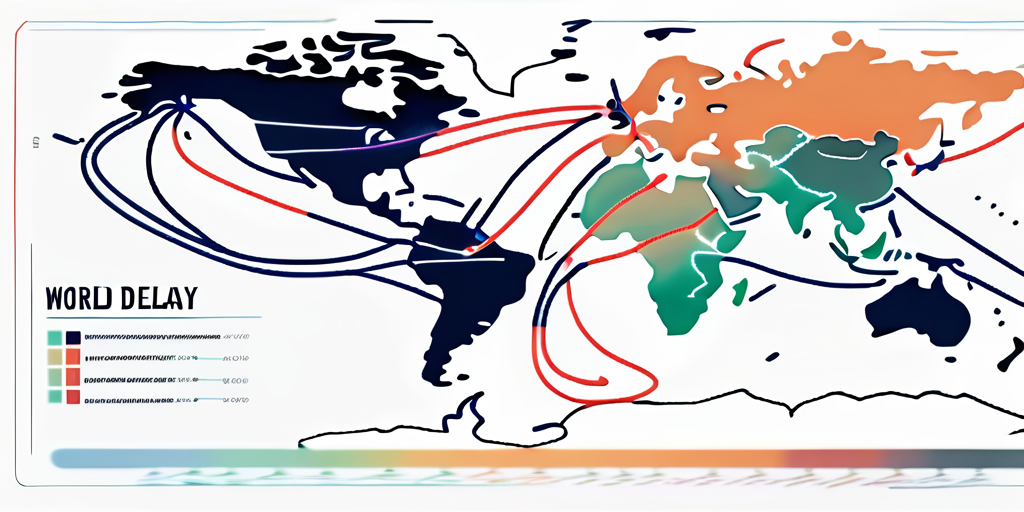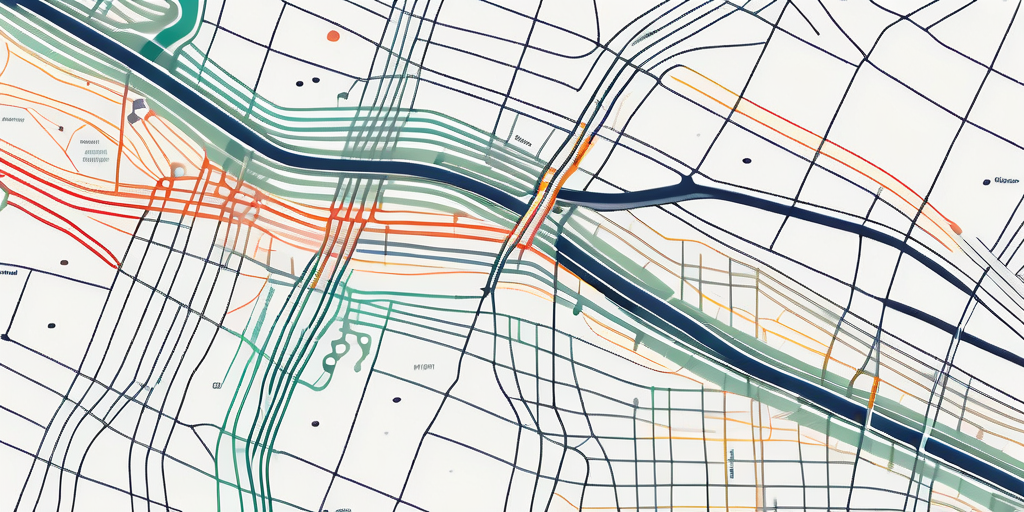Flight Delay Map: Track Delays and Plan Your Travel Efficiently
Stay informed with a flight delay map. Track delays in real-time, plan your travel accordingly, and minimize disruptions for a smoother journey.
In today's fast-paced world, efficient travel planning has become more important than ever. One of the biggest challenges faced by travelers is flight delays, which can disrupt schedules and cause unnecessary stress. However, with the advent of flight delay maps, it has become easier than ever to track delays and plan your travel efficiently. In this article, we will explore the various aspects of flight delay maps and how they can help you have a stress-free travel experience.
Understanding Flight Delays
Before we delve into the details of flight delay maps, let's first understand the common causes of flight delays. These delays can be attributed to a variety of factors, ranging from mechanical issues to air traffic congestion. By having a clear understanding of the reasons behind flight delays, you can better comprehend the significance of flight delay maps in your travel planning.

Common Causes of Flight Delays
Flight delays can occur due to a multitude of reasons. Some common causes include:
- Weather conditions: Adverse weather conditions such as thunderstorms, heavy snow, or fog can significantly impact flight schedules.
- Mechanical issues: Technical problems with the aircraft can cause delays as they need to be resolved before departure for safety reasons.
- Air traffic congestion: Overcrowded airports and busy airspaces can lead to delays in takeoff and landing.
- Airline operational issues: Issues within the airline's operations, such as crew scheduling or unexpected maintenance, can result in delays.
Understanding these common causes will help you appreciate the role that flight delay maps play in mitigating travel disruptions.
The Impact of Weather on Flight Schedules
One of the most significant factors contributing to flight delays is adverse weather conditions. Weather patterns can change rapidly, and airlines strive to ensure the safety of their passengers and crew. Flight delay maps provide real-time information about weather conditions, allowing you to assess the potential impact on your travel plans. By closely monitoring weather patterns, you can make informed decisions and avoid unnecessary delays.
Let's take a closer look at how weather conditions can affect flight schedules. Thunderstorms, for example, are notorious for causing delays. The powerful updrafts and downdrafts associated with thunderstorms pose a significant risk to aircraft. Pilots and air traffic controllers must exercise caution and redirect flights to avoid these hazardous weather conditions. This rerouting process can lead to longer flight times and subsequent delays.
In addition to thunderstorms, heavy snowfall can also wreak havoc on flight schedules. Snow accumulation on runways and taxiways requires diligent snow removal efforts by airport personnel. This process takes time and can lead to delays as aircraft must wait for the runways to be cleared before takeoff or landing. Furthermore, de-icing procedures are often necessary to ensure the safety of the aircraft, adding an additional layer of complexity and potential delays.
Another weather-related factor that can impact flight schedules is fog. Dense fog reduces visibility, making it challenging for pilots to safely navigate during takeoff and landing. Airports have strict visibility requirements, and if these conditions are not met, flights may be delayed until the fog dissipates or visibility improves.
By understanding the specific weather conditions that can cause flight delays, you can better appreciate the importance of flight delay maps. These maps provide valuable information about current weather patterns, allowing you to anticipate potential disruptions and make informed decisions about your travel plans. Whether it's checking for thunderstorms, snowstorms, or foggy conditions, flight delay maps empower you to stay one step ahead and minimize the impact of adverse weather on your journey.
The Role of Flight Delay Maps
Flight delay maps serve as invaluable tools that enable travelers to track delays and plan their journeys efficiently. These maps provide a wealth of information that goes beyond traditional flight status updates. Let's explore how flight delay maps work and the benefits they offer.

How Flight Delay Maps Work
Flight delay maps operate by aggregating data from various sources, such as airlines, airports, and weather services. This data is then visualized on a map, allowing users to view the status of flights and potential delays in real-time. By utilizing advanced technologies and algorithms, flight delay maps make it easier to identify patterns and trends, enabling travelers to make informed decisions.
Benefits of Using Flight Delay Maps
There are several advantages to using flight delay maps in your travel planning:
- Proactive travel planning: Flight delay maps allow you to anticipate and plan for potential delays ahead of time, giving you the advantage of making alternate arrangements or adjusting your schedule accordingly.
- Reduced stress: By staying informed about flight delays, you can minimize the stress associated with unexpected disruptions. Flight delay maps provide you with the power to take control of your travel plans.
- Efficient decision-making: With real-time updates and comprehensive information at your fingertips, you can make well-informed decisions about your travel, such as rebooking flights or choosing alternative routes.
- Optimized travel itineraries: Flight delay maps enable you to create optimized travel itineraries by taking into account potential delays and choosing the most convenient flights.
By harnessing these benefits, you can make the most of flight delay maps and ensure a seamless travel experience.
Imagine this scenario: You have a connecting flight in a busy airport, and you only have a short layover. As you anxiously check your flight delay map, you notice a red icon next to your connecting flight. The map indicates that your flight is delayed by 45 minutes due to air traffic congestion. Armed with this information, you quickly contact the airline's customer service and request a rebooking on a later flight. Thanks to the flight delay map, you avoid the stress and frustration of missing your connection and arrive at your destination on time.
Flight delay maps also provide valuable insights into weather conditions that may affect your travel plans. For example, if you're planning a trip to a tropical destination during hurricane season, the flight delay map can show you the potential impact of severe weather on your flights. Armed with this knowledge, you can make informed decisions about whether to proceed with your travel plans or reschedule your trip to a safer time.
Furthermore, flight delay maps can help you navigate through busy airports more efficiently. By displaying the real-time status of each flight, these maps allow you to identify congestion points and choose alternative routes or gates. This can save you precious time and energy, especially during peak travel seasons when airports are bustling with passengers.
Strategies for Efficient Travel Planning
Now that you understand the significance of flight delay maps, it's time to incorporate them into your travel planning. Here are some strategies to make the most of these invaluable tools:
Incorporating Flight Delay Maps into Your Travel Plans
When planning your journey, make it a habit to consult flight delay maps regularly. By staying updated with the latest information, you can proactively adjust your travel plans and avoid potential delays. Incorporate the use of these maps into your itinerary right from the start to ensure a smooth and hassle-free trip.
Tips for Dealing with Potential Flight Delays
Despite your best efforts, there may still be instances when you encounter flight delays. Here are a few tips to help you navigate through potential disruptions:
- Stay connected: Make sure you have access to reliable sources of information, such as airline apps or airport websites, to stay informed about any delays or changes to your flight.
- Take advantage of amenities: If you find yourself facing an extended delay, utilize airport amenities such as lounges or restaurants to relax and make the most of your time.
- Communicate with your airline: In case of a significant delay, reach out to the airline's customer service to explore alternative options or seek assistance.
- Have a backup plan: Prepare for contingencies by having a backup travel plan that includes alternative flights or accommodations.
By following these tips, you can effectively deal with potential flight delays and minimize any inconvenience they may cause.
Advanced Features of Flight Delay Maps
Flight delay maps continue to evolve, offering advanced features and functionalities to enhance the travel experience. Let's explore some of these innovative capabilities:

Real-Time Tracking and Updates
With real-time tracking and updates, flight delay maps provide you with the latest information about flight statuses, gate changes, and other crucial details. These valuable insights ensure that you are constantly aware of any changes in your travel plans.
Predictive Capabilities of Flight Delay Maps
Thanks to predictive algorithms, flight delay maps can forecast potential delays based on historical data and current conditions. This allows you to assess the likelihood of disruptions and plan accordingly, minimizing the impact on your travel plans.
Making the Most of Flight Delay Maps
To make the most of flight delay maps, consider adopting the following best practices:
Best Practices for Using Flight Delay Maps
-
Regularly check flight delay maps: Stay informed about any potential delays or changes to your flights by consistently monitoring flight delay maps.
-
Plan ahead: Utilize the information provided by flight delay maps to plan your travel in advance, factoring in potential delays and making alternate arrangements if necessary.
-
Stay flexible: Maintain flexibility in your itinerary to accommodate unexpected delays or changes. Having backup options can save you from unnecessary stress.
Flight Delay Maps and Stress-Free Travel
Flight delay maps have revolutionized the way we plan our travels. By providing real-time information, predictive capabilities, and a wealth of valuable insights, these maps empower travelers to track delays and plan their journeys with confidence. Incorporating flight delay maps into your travel planning ensures stress-free travel, allowing you to focus on the enjoyable aspects of your trip.
So, the next time you plan a journey, make sure to leverage the power of flight delay maps and navigate through delays with ease!
Get the Compensation You Deserve with ClaimCompass
While flight delay maps are a fantastic tool for planning ahead and avoiding travel disruptions, sometimes delays are simply unavoidable. If you've experienced a flight delay, cancellation, or overbooking, ClaimCompass is here to help you claim up to 600€ in compensation. We specialize in air passenger rights in Europe and work tirelessly on your behalf, handling everything from submitting your claim to the airline to legal proceedings if necessary. Our expertise in EU Regulation 261/2004 ensures that we can quickly determine your eligibility for compensation. Use our compensation calculator to check for free if you're entitled to compensation and let us take care of the rest. Remember, there's no fee unless we succeed, and if we do, we only keep a 35% commission. Don't let flight disruptions set you back—submit a claim with ClaimCompass and let us secure the compensation you're owed.
